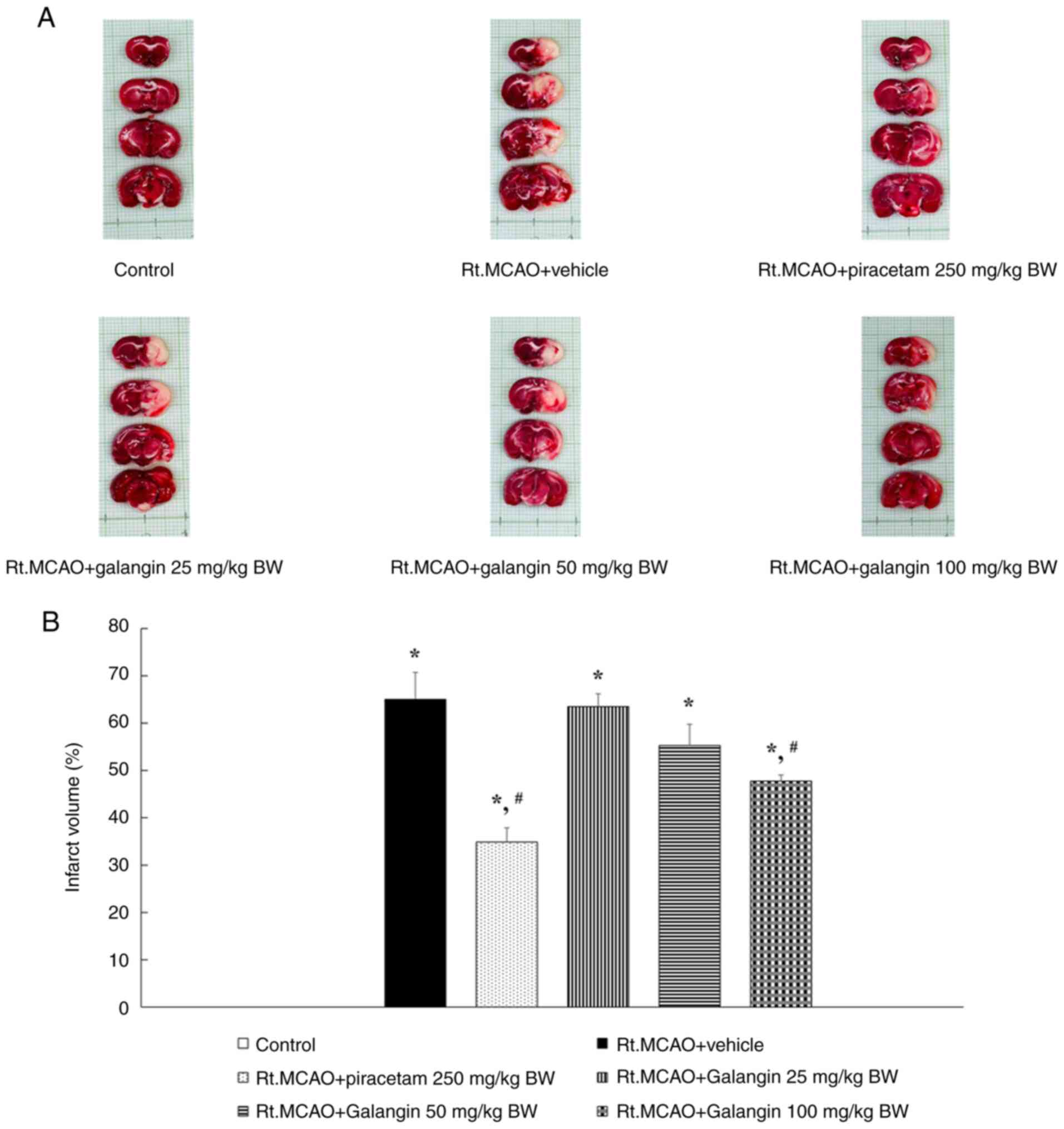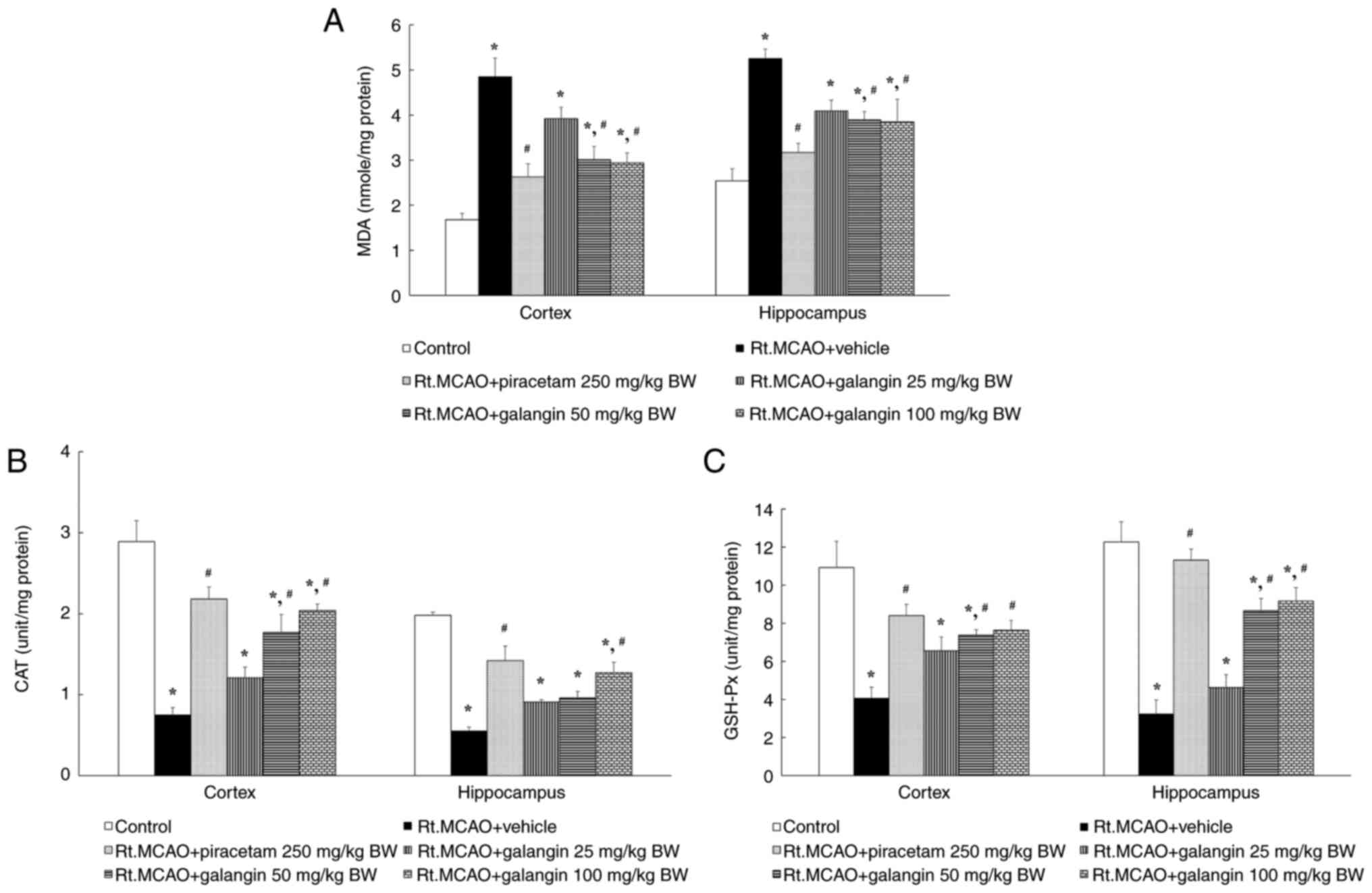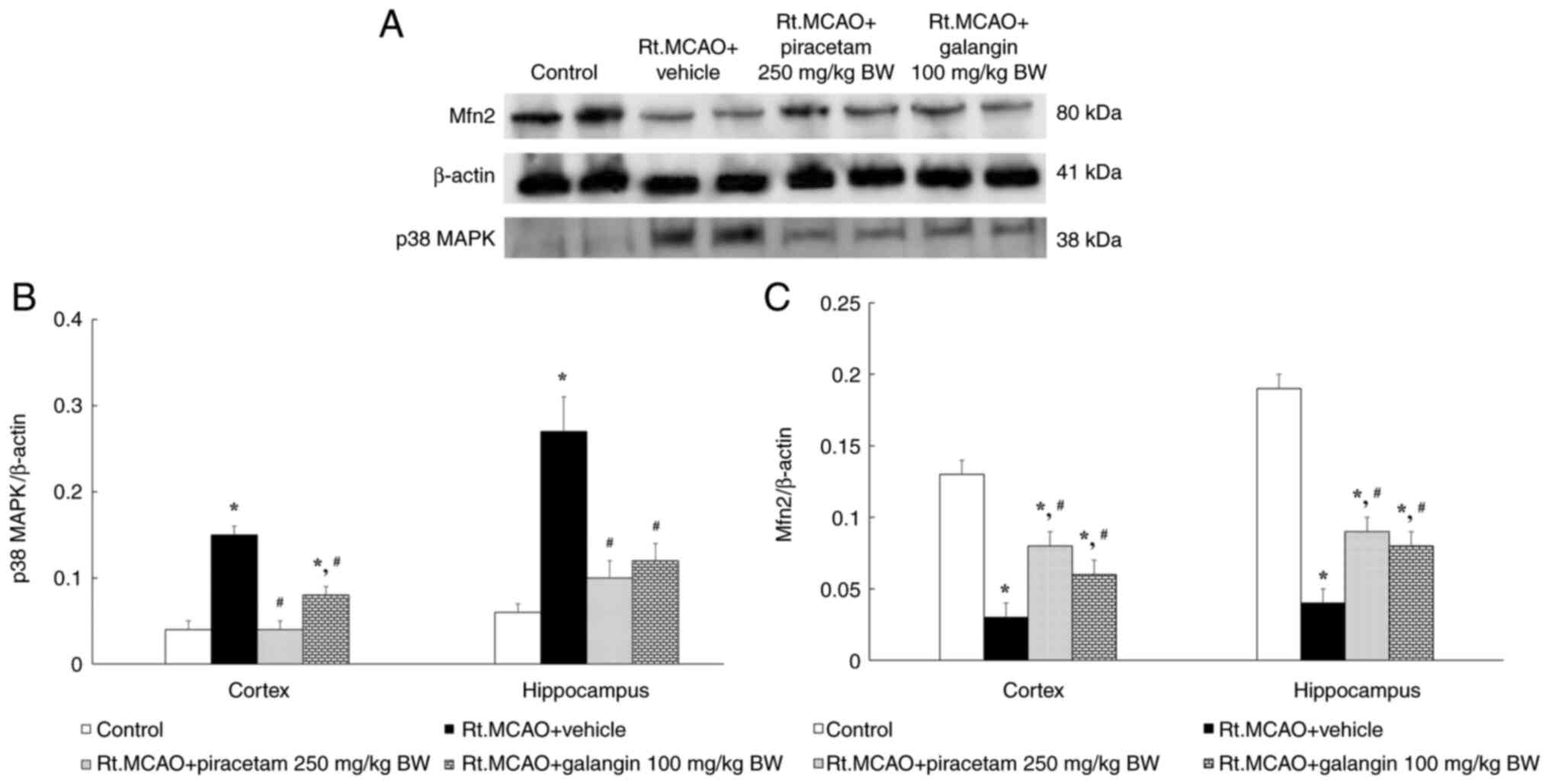|
1
|
Donkor ES: Stroke in the 21st Century: A
Snapshot of the Burden, epidemiology, and quality of life. Stroke
Res Treat. 2018(3238165)2018.PubMed/NCBI View Article : Google Scholar
|
|
2
|
Shirley R, Ord EN and Work LM: Oxidative
Stress and the Use of Antioxidants in Stroke. Antioxidants (Basel).
3:472–501. 2014.PubMed/NCBI View Article : Google Scholar
|
|
3
|
Rabinstein AA: Treatment of acute ischemic
stroke. Continuum (Minneap Minn). 23:62–81. 2017.PubMed/NCBI View Article : Google Scholar
|
|
4
|
Jaffer H, Morris VB, Stewart D and
Labhasetwar V: Advances in stroke therapy. Drug Deliv Transl Res.
1:409–419. 2011.PubMed/NCBI View Article : Google Scholar
|
|
5
|
Garcia-Sanchez A, Miranda-Diaz AG and
Cardona-Munoz EG: The Role of oxidative stress in physiopathology
and pharmacological treatment with pro- and antioxidant properties
in chronic diseases. Oxid Med Cell Longev.
2020(2082145)2020.PubMed/NCBI View Article : Google Scholar
|
|
6
|
Kiechl S and Willeit J: Alteplase in acute
ischaemic stroke: no time to slow down. Lancet Neurol. 15:893–895.
2016.PubMed/NCBI View Article : Google Scholar
|
|
7
|
Feng S, Yang M, Liu S, He Y, Deng S and
Gong Y: Oxidative stress as a bridge between age and stroke: A
narrative review. J Intensive Med. 3:313–319. 2023.PubMed/NCBI View Article : Google Scholar
|
|
8
|
Olufunmilayo EO, Gerke-Duncan MB and
Holsinger RMD: Oxidative stress and antioxidants in
neurodegenerative disorders. Antioxidants (Basel).
12(517)2023.PubMed/NCBI View Article : Google Scholar
|
|
9
|
Li P, Stetler RA, Leak RK, Shi Y, Li Y, Yu
W, Bennett MVL and Chen J: Oxidative stress and DNA damage after
cerebral ischemia: Potential therapeutic targets to repair the
genome and improve stroke recovery. Neuropharmacology. 134:208–217.
2018.PubMed/NCBI View Article : Google Scholar
|
|
10
|
Kongsui R and Jittiwat J: Ameliorative
effects of 6-gingerol in cerebral ischemia are mediated via the
activation of antioxidant and anti-inflammatory pathways. Biomed
Rep. 18(26)2023.PubMed/NCBI View Article : Google Scholar
|
|
11
|
Jittiwat J, Suksamrarn A, Tocharus C and
Tocharus J: Dihydrocapsaicin effectively mitigates cerebral
ischemia-induced pathological changes in vivo, partly via
antioxidant and anti-apoptotic pathways. Life Sci.
283(119842)2021.PubMed/NCBI View Article : Google Scholar
|
|
12
|
Kongsui R and Jittiwat J: In vivo
protective effects of 6-gingerol in cerebral ischemia involve
preservation of antioxidant defenses and activation of
anti-apoptotic pathways. Biomed Rep. 20(85)2024.PubMed/NCBI View Article : Google Scholar
|
|
13
|
Li C, Chen C, Qin H, Ao C, Chen J, Tan J
and Zeng L: The role of mitochondrial dynamin in stroke. Oxid Med
Cell Longev. 2022(2504798)2022.PubMed/NCBI View Article : Google Scholar
|
|
14
|
Zhang XM, Zhang L, Wang G, Niu W, He Z,
Ding L and Jia J: Suppression of mitochondrial fission in
experimental cerebral ischemia: The potential neuroprotective
target of p38 MAPK inhibition. Neurochem Int. 90:1–8.
2015.PubMed/NCBI View Article : Google Scholar
|
|
15
|
Heo MY, Sohn SJ and Au WW:
Anti-genotoxicity of galangin as a cancer chemopreventive agent
candidate. Mutat Res. 488:135–150. 2001.PubMed/NCBI View Article : Google Scholar
|
|
16
|
Aloud AA, Veeramani C, Govindasamy C,
Alsaif MA and Al-Numair KS: Galangin, a natural flavonoid reduces
mitochondrial oxidative damage in streptozotocin-induced diabetic
rats. Redox Rep. 23:29–34. 2018.PubMed/NCBI View Article : Google Scholar
|
|
17
|
Aloud AA, Veeramani C, Govindasamy C,
Alsaif MA, El Newehy AS and Al-Numair KS: Galangin, a dietary
flavonoid, improves antioxidant status and reduces
hyperglycemia-mediated oxidative stress in streptozotocin-induced
diabetic rats. Redox Rep. 22:290–300. 2017.PubMed/NCBI View Article : Google Scholar
|
|
18
|
Thangaiyan R, Arjunan S, Govindasamy K,
Khan HA, Alhomida AS and Prasad NR: Galangin attenuates
isoproterenol-induced inflammation and fibrosis in the cardiac
tissue of albino Wistar rats. Front Pharmacol.
11(585163)2020.PubMed/NCBI View Article : Google Scholar
|
|
19
|
Lee HN, Shin SA, Choo GS, Kim HJ, Park YS,
Kim BS, Kim SK, Cho SD, Nam JS, Choi CS, et al: Anti-inflammatory
effect of quercetin and galangin in LPS-stimulated RAW264.7
macrophages and DNCB-induced atopic dermatitis animal models. Int J
Mol Med. 41:888–898. 2018.PubMed/NCBI View Article : Google Scholar
|
|
20
|
Lin K, Wang Y, Gong J, Tan Y, Deng T and
Wei N: Protective effects of total flavonoids from Alpinia
officinarum rhizoma against ethanol-induced gastric ulcer in vivo
and in vitro. Pharm Biol. 58:854–862. 2020.PubMed/NCBI View Article : Google Scholar
|
|
21
|
Gong J, Zhang Z, Zhang X, Chen F, Tan Y,
Li H, Jiang J and Zhang J: Effects and possible mechanisms of
Alpinia officinarum ethanol extract on indomethacin-induced gastric
injury in rats. Pharm Biol. 56:294–301. 2018.PubMed/NCBI View Article : Google Scholar
|
|
22
|
Aloud AA, Chinnadurai V, Govindasamy C,
Alsaif MA and Al-Numair KS: Galangin, a dietary flavonoid,
ameliorates hyperglycaemia and lipid abnormalities in rats with
streptozotocin-induced hyperglycaemia. Pharm Biol. 56:302–308.
2018.PubMed/NCBI View Article : Google Scholar
|
|
23
|
Abukhalil MH, Althunibat OY, Aladaileh SH,
Al-Amarat W, Obeidat HM, Al-Khawalde AAA, Hussein OE, Alfwuaires
MA, Algefare AI, Alanazi KM, et al: Galangin attenuates diabetic
cardiomyopathy through modulating oxidative stress, inflammation
and apoptosis in rats. Biomed Pharmacother.
138(111410)2021.PubMed/NCBI View Article : Google Scholar
|
|
24
|
Jin Y, Yang P and Wang L, Gao Z, Lv J, Cui
Z, Wang T, Wang D and Wang L: Galangin as a direct inhibitor of
vWbp protects mice from Staphylococcus aureus-induced pneumonia. J
Cell Mol Med. 26:828–839. 2022.PubMed/NCBI View Article : Google Scholar
|
|
25
|
Huang YC, Tsai MS, Hsieh PC, Shih JH, Wang
TS, Wang YC, Lin TH and Wang SH: Galangin ameliorates
cisplatin-induced nephrotoxicity by attenuating oxidative stress,
inflammation and cell death in mice through inhibition of ERK and
NF-kappaB signaling. Toxicol Appl Pharmacol. 329:128–139.
2017.PubMed/NCBI View Article : Google Scholar
|
|
26
|
Li S, Wu C, Zhu L, Gao J, Fang J, Li D, Fu
M, Liang R, Wang L, Cheng M and Yang H: By improving regional
cortical blood flow, attenuating mitochondrial dysfunction and
sequential apoptosis galangin acts as a potential neuroprotective
agent after acute ischemic stroke. Molecules. 17:13403–13423.
2012.PubMed/NCBI View Article : Google Scholar
|
|
27
|
Tortiglione A, Minale M, Pignataro G,
Amoroso S, DiRenzo G and Annunziato L: The 2-oxopyrrolidinacetamide
piracetam reduces infarct brain volume induced by permanent middle
cerebral artery occlusion in male rats. Neuropharmacology.
43:427–433. 2002.PubMed/NCBI View Article : Google Scholar
|
|
28
|
Kessler J, Thiel A, Karbe H and Heiss WD:
Piracetam improves activated blood flow and facilitates
rehabilitation of poststroke aphasic patients. Stroke.
31:2112–2116. 2000.PubMed/NCBI View Article : Google Scholar
|
|
29
|
Yang Y, Feng J, Xu F and Wang J: Piracetam
inhibits ethanol (EtOH)-induced memory deficit by mediating
multiple pathways. Brain Res. 1676:83–90. 2017.PubMed/NCBI View Article : Google Scholar
|
|
30
|
Janyou A, Wicha P, Jittiwat J, Suksamrarn
A, Tocharus C and Tocharus J: Dihydrocapsaicin attenuates blood
brain barrier and cerebral damage in focal cerebral
ischemia/reperfusion via oxidative stress and inflammatory. Sci
Rep. 7(10556)2017.PubMed/NCBI View Article : Google Scholar
|
|
31
|
Jittiwat J: Baihui point laser acupuncture
ameliorates cognitive impairment, motor deficit, and neuronal loss
partly via antioxidant and anti-inflammatory effects in an animal
model of focal ischemic stroke. Evid Based Complement Alternat Med.
2019(1204709)2019.PubMed/NCBI View Article : Google Scholar
|
|
32
|
Jittiwat J, Chonpathompikunlert P and
Sukketsiri W: Neuroprotective effects of Apium graveolens against
focal cerebral ischemia occur partly via antioxidant,
anti-inflammatory, and anti-apoptotic pathways. J Sci Food Agric.
101:2256–2263. 2021.PubMed/NCBI View Article : Google Scholar
|
|
33
|
Lowry OH, Rosebrough NJ, Farr AL and
Randall RJ: Protein measurement with the Folin phenol reagent. J
Biol Chem. 193:265–275. 1951.PubMed/NCBI
|
|
34
|
Ohkawa H, Ohishi N and Yagi K: Assay for
lipid peroxides in animal tissues by thiobarbituric acid reaction.
Anal Biochem. 95:351–358. 1979.PubMed/NCBI View Article : Google Scholar
|
|
35
|
Goldblith SA and Proctor BE: Photometric
determination of catalase activity. J Biol Chem. 187:705–709.
1950.PubMed/NCBI
|
|
36
|
Wu L, Xiong X, Wu X, Ye Y, Jian Z, Zhi Z
and Gu L: Targeting oxidative stress and inflammation to prevent
ischemia-reperfusion injury. Front Mol Neurosci.
13(28)2020.PubMed/NCBI View Article : Google Scholar
|
|
37
|
Nakano S, Iseda T, Kawano H, Yoneyama T,
Ikeda T and Wakisaka S: Correlation of early CT signs in the deep
middle cerebral artery territories with angiographically confirmed
site of arterial occlusion. AJNR Am J Neuroradiol. 22:654–659.
2001.PubMed/NCBI
|
|
38
|
Allen LM, Hasso AN, Handwerker J and Farid
H: Sequence-specific MR imaging findings that are useful in dating
ischemic stroke. Radiographics. 32:1285–1289. 2012.PubMed/NCBI View Article : Google Scholar
|
|
39
|
Zhang D, Ren J, Luo Y, He Q, Zhao R, Chang
J, Yang Y and Guo ZN: T cell response in ischemic stroke: From
mechanisms to translational insights. Front Immunol.
12(707972)2021.PubMed/NCBI View Article : Google Scholar
|
|
40
|
Guan X, Li Z, Zhu S, Cheng M, Ju Y, Ren L,
Yang G and Min D: Galangin attenuated cerebral ischemia-reperfusion
injury by inhibition of ferroptosis through activating the
SLC7A11/GPX4 axis in gerbils. Life Sci. 264(118660)2021.PubMed/NCBI View Article : Google Scholar
|
|
41
|
Jomova K, Raptova R, Alomar SY, Alwasel
SH, Nepovimova E, Kuca K and Valko M: Reactive oxygen species,
toxicity, oxidative stress, and antioxidants: Chronic diseases and
aging. Arch Toxicol. 97:2499–2574. 2023.PubMed/NCBI View Article : Google Scholar
|
|
42
|
Birben E, Sahiner UM, Sackesen C, Erzurum
S and Kalayci O: Oxidative stress and antioxidant defense. World
Allergy Organ J. 5:9–19. 2012.PubMed/NCBI View Article : Google Scholar
|
|
43
|
Khanum R and Thevanayagam H: Lipid
peroxidation: Its effects on the formulation and use of
pharmaceutical emulsions. Asian J Pharm Sci. 12:401–411.
2017.PubMed/NCBI View Article : Google Scholar
|
|
44
|
Montine KS, Quinn JF, Zhang J, Fessel JP,
Roberts LJ II, Morrow JD and Montine TJ: Isoprostanes and related
products of lipid peroxidation in neurodegenerative diseases. Chem
Phys Lipids. 128:117–124. 2004.PubMed/NCBI View Article : Google Scholar
|
|
45
|
Mohammadi A, Kazemi S, Molayousefian I,
Pirzadeh M and Moghadamnia AA: Galangin nanoparticles protect
acetaminophen-induced liver injury: A biochemical and
histopathological approach. Evid Based Complement Alternat Med.
2022(4619064)2022.PubMed/NCBI View Article : Google Scholar
|
|
46
|
Prasatthong P, Meephat S, Rattanakanokchai
S, Khamseekaew J, Bunbupha S, Prachaney P, Maneesai P and
Pakdeechote P: Galangin resolves cardiometabolic disorders through
modulation of AdipoR1, COX-2, and NF-ĸB expression in rats fed a
high-fat diet. Antioxidants (Basel). 10(769)2021.PubMed/NCBI View Article : Google Scholar
|
|
47
|
Gusti AMT, Qusti SY, Alshammari EM, Toraih
EA and Fawzy MS: Antioxidants-related superoxide dismutase (SOD),
Catalase (CAT), glutathione peroxidase (GPX),
Glutathione-S-Transferase (GST), and Nitric Oxide Synthase (NOS)
gene variants analysis in an obese population: A preliminary
case-control study. Antioxidants (Basel). 10(595)2021.PubMed/NCBI View Article : Google Scholar
|
|
48
|
Lubrano V and Balzan S: Enzymatic
antioxidant system in vascular inflammation and coronary artery
disease. World J Exp Med. 5:218–224. 2015.PubMed/NCBI View Article : Google Scholar
|
|
49
|
Ullah A, Munir S, Badshah SL, Khan N,
Ghani L, Poulson BG, Emwas AH and Jaremko M: Important flavonoids
and their role as a therapeutic agent. Molecules.
25(5243)2020.PubMed/NCBI View Article : Google Scholar
|
|
50
|
Gui C, Ren Y, Chen J, Wu X, Mao K, Li H,
Yu H, Zou F and Li W: p38 MAPK-DRP1 signaling is involved in
mitochondrial dysfunction and cell death in mutant A53T α-synuclein
model of Parkinson's disease. Toxicol Appl Pharmacol.
388(114874)2020.PubMed/NCBI View Article : Google Scholar
|
|
51
|
Huan Y, Hao G, Shi Z, Liang Y, Dong Y and
Quan H: The role of dynamin-related protein 1 in cerebral
ischemia/hypoxia injury. Biomed Pharmacother.
165(115247)2023.PubMed/NCBI View Article : Google Scholar
|
|
52
|
Zhao YX, Cui M, Chen SF, Dong Q and Liu
XY: Amelioration of ischemic mitochondrial injury and Bax-dependent
outer membrane permeabilization by Mdivi-1. CNS Neurosci Ther.
20:528–538. 2014.PubMed/NCBI View Article : Google Scholar
|
|
53
|
Kumar S, Chhabra V, Shenoy S, Daksh R,
Ravichandiran V, Swamy RS and Kumar N: Role of flavonoids in
modulation of mitochondria dynamics during oxidative stress. Mini
Rev Med Chem. 24:908–919. 2024.PubMed/NCBI View Article : Google Scholar
|
|
54
|
Faleye OS, Lee JH and Lee J: Selected
flavonoids exhibit antibiofilm and antibacterial effects against
Vibrio by disrupting membrane integrity, virulence and metabolic
activities. Biofilm. 6(100165)2023.PubMed/NCBI View Article : Google Scholar
|
|
55
|
Parmenter BH, Croft KD, Hodgson JM,
Dalgaard F, Bondonno CP, Lewis JR, Cassidy A, Scalbert A and
Bondonno NP: An overview and update on the epidemiology of
flavonoid intake and cardiovascular disease risk. Food Funct.
11:6777–6806. 2020.PubMed/NCBI View Article : Google Scholar
|
|
56
|
Zhao L, Yuan X, Wang J, Feng Y, Ji F, Li Z
and Bian J: A review on flavones targeting serine/threonine protein
kinases for potential anticancer drugs. Bioorg Med Chem.
27:677–685. 2019.PubMed/NCBI View Article : Google Scholar
|
|
57
|
Patel DK: Medicinal importance,
pharmacological activity and analytical aspects of flavonoid
‘Irisflorentin’ from Belamcanda chinensis (L.) DC. Curr Drug Res
Rev. 15:222–227. 2023.PubMed/NCBI View Article : Google Scholar
|
|
58
|
Wang D, Chen J, Pu L, Yu L, Xiong F, Sun
L, Yu Q, Cao X, Chen Y, Peng F and Peng C: Galangin: A food-derived
flavonoid with therapeutic potential against a wide spectrum of
diseases. Phytother Res. 37:5700–5723. 2023.PubMed/NCBI View Article : Google Scholar
|
|
59
|
Lin K, Deng T, Qu H, Ou H, Huang Q, Gao B,
Li X and Wei N: Gastric protective effect of Alpinia officinarum
flavonoids: Mediating TLR4/NF-ĸB and TRPV1 signalling pathways and
gastric mucosal healing. Pharm Biol. 61:50–60. 2023.PubMed/NCBI View Article : Google Scholar
|
|
60
|
Lin K, Fu D, Wang Z, Zhang X and Zhu C:
Analgesic and anti-inflammatory effects of galangin: A potential
pathway to inhibit transient receptor potential vanilloid 1
receptor activation. Korean J Pain. 37:151–163. 2024.PubMed/NCBI View Article : Google Scholar
|















